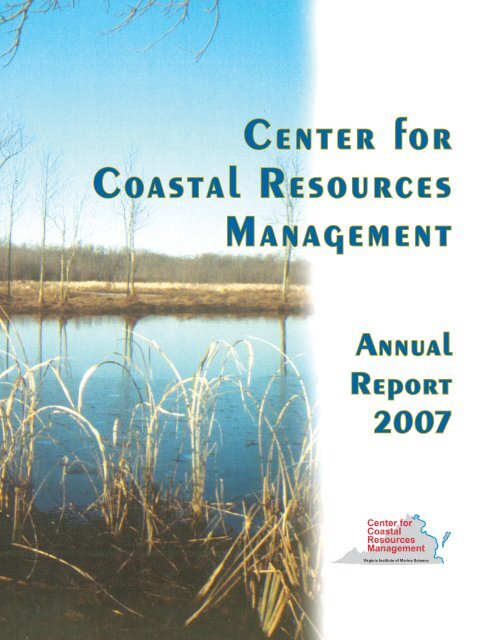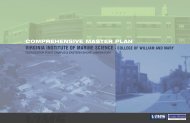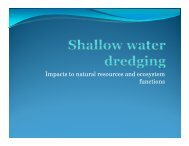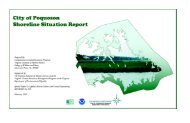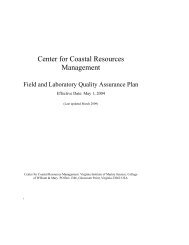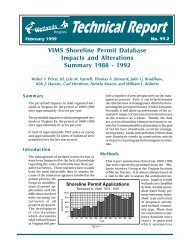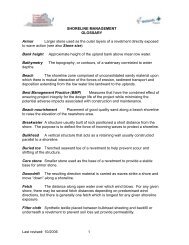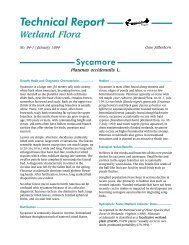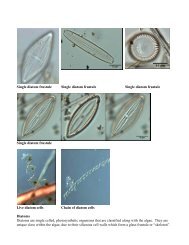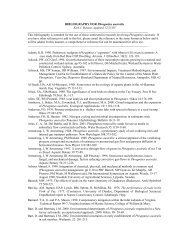2007 - Center for Coastal Resources Management - Virginia Institute ...
2007 - Center for Coastal Resources Management - Virginia Institute ...
2007 - Center for Coastal Resources Management - Virginia Institute ...
Create successful ePaper yourself
Turn your PDF publications into a flip-book with our unique Google optimized e-Paper software.
<strong>Center</strong> <strong>for</strong><br />
<strong>Coastal</strong> <strong>Resources</strong><br />
<strong>Management</strong><br />
Annual<br />
Report<br />
<strong>2007</strong>
“The Wetlands Program provides extensive support to<br />
the Commonwealth’s tidal wetlands and subaqueous<br />
lands management programs through review of<br />
individual tidal wetland permit applications, training<br />
<strong>for</strong> local and state managers, and development/<br />
management of data bases supporting and tracking<br />
regulatory program activities.”
<strong>Center</strong> <strong>for</strong><br />
<strong>Coastal</strong> <strong>Resources</strong> <strong>Management</strong><br />
WILLIAM&MARY VIRGINIA INSTITUTE OF MARINE SCIENCE<br />
SCHOOL OF MARINE SCIENCE<br />
<strong>2007</strong> Annual Report<br />
<strong>Virginia</strong> <strong>Institute</strong> of Marine Science<br />
P.O. Box 1346<br />
Gloucester Point, <strong>Virginia</strong> 23062<br />
<strong>Center</strong> <strong>for</strong><br />
<strong>Coastal</strong><br />
<strong>Resources</strong><br />
<strong>Management</strong><br />
<strong>Virginia</strong> <strong>Institute</strong> of Marine Science
Report Contents<br />
<strong>Center</strong> Programs . . . . . . . . . . . . . . . . . . . . . . . . . . . . . . . . . . . . . . . . . . . 1<br />
Background . . . . . . . . . . . . . . . . . . . . . . . . . . . . . . . . . . . . . . . . . . . 2<br />
Wetlands Program . . . . . . . . . . . . . . . . . . . . . . . . . . . . . . . . . . 2<br />
<strong>Coastal</strong> Inventory Program . . . . . . . . . . . . . . . . . . . . . . . . . . . 4<br />
<strong>Coastal</strong> Watersheds Program . . . . . . . . . . . . . . . . . . . . . . . . . 5<br />
Personnel and Funding . . . . . . . . . . . . . . . . . . . . . . . . . . . . . . . . . . 6<br />
Organizational Chart . . . . . . . . . . . . . . . . . . . . . . . . . . . . . . . . . . . . 7<br />
<strong>Center</strong> Fellows . . . . . . . . . . . . . . . . . . . . . . . . . . . . . . . . . . . . . . . . . 8<br />
<strong>Center</strong> Adjunct Research Faculty . . . . . . . . . . . . . . . . . . . . . . . . . . 9<br />
<strong>Center</strong> Associate Researchers . . . . . . . . . . . . . . . . . . . . . . . . . . . 10<br />
<strong>Center</strong> Graduate Students . . . . . . . . . . . . . . . . . . . . . . . . . . . . . . . 11<br />
<strong>Center</strong> Collaborations . . . . . . . . . . . . . . . . . . . . . . . . . . . . . . . . . . 12<br />
<strong>Center</strong> Projects . . . . . . . . . . . . . . . . . . . . . . . . . . . . . . . . . . . . . . . . . . . . 13<br />
Advisory Activities . . . . . . . . . . . . . . . . . . . . . . . . . . . . . . . . . . . . . . . . . 31<br />
Advisory Activity Table . . . . . . . . . . . . . . . . . . . . . . . . . . . . . . . . . . 32<br />
Advisory Committees . . . . . . . . . . . . . . . . . . . . . . . . . . . . . . . . . . . 33<br />
Outreach Education Classes . . . . . . . . . . . . . . . . . . . . . . . . . . . . . 34<br />
After Hours Lectures . . . . . . . . . . . . . . . . . . . . . . . . . . . . . . . . . . . 36<br />
Website Statistics . . . . . . . . . . . . . . . . . . . . . . . . . . . . . . . . . . . . . . 38<br />
Publications . . . . . . . . . . . . . . . . . . . . . . . . . . . . . . . . . . . . . . . . . . . . . . 39<br />
CCRM Quality Assurance/Quality Control Policy . . . . . . . . . . . . . . . . . 41
Seashore mallow; <strong>Coastal</strong> mallow<br />
Kosteletzkya virginica<br />
<strong>Center</strong><br />
Programs
Background<br />
The <strong>Center</strong> <strong>for</strong> <strong>Coastal</strong> <strong>Resources</strong> <strong>Management</strong> exists to develop and support integrated and<br />
adaptive management of coastal zone resources. To fulfill this mission, the <strong>Center</strong> undertakes<br />
research, provides advisory service, and conducts outreach education. These tasks are<br />
carried out by a staff of professional scientists and technical experts using a mix of state<br />
funding and grant/contract support.<br />
Within its broader mission, the <strong>Center</strong> has specific tasks to support <strong>Virginia</strong>’s wetlands<br />
and shoreline management programs. These core activities create a natural focus on the<br />
littoral zone and riparian lands in coastal and estuarine areas. <strong>Management</strong> of resources in<br />
these areas has evolved from resource-specific considerations to system-level perspectives.<br />
The <strong>Center</strong> has been an active agent in this change, and has developed the required<br />
internal capabilities and external collaborations to support multidisciplinary approaches to<br />
management and policy issues.<br />
The <strong>Center</strong> currently manages its multiple activities within three broad and interacting<br />
programs.<br />
The Wetlands Program<br />
The Wetlands Program deals with both tidal and nontidal wetlands. The program conducts<br />
basic research on the structure and functions of these systems, collaborating with researchers<br />
throughout the mid-Atlantic region. A wide variety of applied research is also undertaken. This<br />
includes policy option analysis, functional assessment methods, inventory and monitoring<br />
techniques, and creation/restoration protocols. The Wetlands Program provides extensive<br />
support to the Commonwealths tidal wetlands and subaqueous lands management programs<br />
through review of individual tidal wetland permit applications, training <strong>for</strong> local and state<br />
managers, and development/ management of data bases supporting and tracking regulatory<br />
program activities.
Permits Reviewed 1972 - <strong>2007</strong><br />
<strong>2007</strong> <strong>Virginia</strong> Permit Sites
<strong>Coastal</strong> Inventory Program<br />
The <strong>Coastal</strong> Inventory Program has a basic mission to monitor tidal shoreline conditions and<br />
to develop policy/management recommendations based on analysis of that in<strong>for</strong>mation. The<br />
<strong>Coastal</strong> Inventory Program has developed extensive capabilities in geographic in<strong>for</strong>mation<br />
systems and in analysis of remotely sensed in<strong>for</strong>mation. It has expanded its inventorying<br />
activities to include almost all terrestrial and aquatic resources within the coastal zone in<br />
support of the <strong>Center</strong>’s focus on integrated and adaptive management. Development of GIS-<br />
based analytical protocols has become a major activity in the <strong>Coastal</strong> Inventory. Development<br />
of these tools has proven to be a most effective mechanism <strong>for</strong> integrating technical<br />
understanding and extensive data sets in a <strong>for</strong>mat that is comprehensible and in<strong>for</strong>mative <strong>for</strong><br />
managers. The <strong>Coastal</strong> Inventory generates detailed shoreline condition inventories <strong>for</strong> every<br />
tidal county and city as part of its basic mission, and shares its extensive GIS data bases with<br />
state and federal agencies throughout the region.<br />
4
<strong>Coastal</strong> Watersheds Program<br />
The <strong>Coastal</strong> Watersheds Program evolved to deal with the water<br />
quality/quantity, land use, and habitat issues that were part of integrated management of<br />
coastal resources. The program focuses on basic and applied research in support of policy<br />
and regulation development. There are both regional and international elements in the<br />
<strong>Coastal</strong> Watershed Program. The program is working on development of indicators <strong>for</strong> health<br />
of aquatic ecosystems, use conflict management plans <strong>for</strong> shallow waters, anadromous fish<br />
spawning and nursery habitat studies, and climate change impact assessments. Because<br />
much of the work on use conflict analysis, shallow water management, and fishery habitat<br />
assessment is of interest in coastal systems around the world, the <strong>Center</strong> manages growing<br />
international collaborations through the <strong>Coastal</strong> Watersheds Program.<br />
5
Personnel and Funding<br />
The <strong>Center</strong> has a full time staff of about individuals and supports several graduate<br />
students. The staffing varies slightly depending on grant and contract activities. Currently the<br />
Commonwealth of <strong>Virginia</strong> provides base funding <strong>for</strong> the <strong>Center</strong> that covers less than 50% of<br />
the salary expenses and about 5% of the annual operating expenses. The balance of funding<br />
is derived from grant and contract activity. The primary sources of this support have been the<br />
U.S. Environmental Protection Agency and <strong>Virginia</strong>’s <strong>Coastal</strong> Resource <strong>Management</strong> Program<br />
(funding from NOAA). Other sources of recent funding have included National Oceanic and<br />
Atmospheric Administration, National Science Foundation, <strong>Virginia</strong> Department of Health,<br />
<strong>Virginia</strong> Department of Conservation and Recreation, and private donors.
<strong>Center</strong> <strong>for</strong> <strong>Coastal</strong><br />
<strong>Resources</strong> <strong>Management</strong><br />
John Wells<br />
VIMS Dean and Director<br />
Roger Mann<br />
Director <strong>for</strong> Research and<br />
Advisory Service<br />
Inez Boerner<br />
Administrative Assistant<br />
Dawn Fleming<br />
Administrative Coordinator<br />
Agnes Lewis<br />
Business Manager A<br />
Carl Hershner<br />
Director, <strong>Center</strong> <strong>for</strong> <strong>Coastal</strong><br />
<strong>Resources</strong> <strong>Management</strong><br />
Comprehensive <strong>Coastal</strong> Inventory <strong>Coastal</strong> Watersheds Program Wetlands Program<br />
David O’Brien<br />
Program Director<br />
Kirk Havens<br />
Assistant Director, CCRM<br />
Marcia Berman<br />
Program Director<br />
Julie Bradshaw<br />
Marine Scientist, Sr.<br />
Donna Bilkovic<br />
Research Associate<br />
Julie Herman<br />
Research Associate<br />
Harry Berquist<br />
Sr. Programmer/<br />
Analyst<br />
Karen Duhring<br />
Marine Scientist Supervisor<br />
Sharon Killeen<br />
Programmer/Analyst<br />
Mary Huang<br />
Graduate Intern<br />
Karen Reay<br />
Internet Database Manager<br />
Pam Mason<br />
Marine Scientist Supervisor<br />
Dan Schatt<br />
Programmer/Analyst<br />
Karinna Nunez<br />
GIS Specialist<br />
Dave Stanhope<br />
Lab/Research Manager<br />
Tamia Rudnicky<br />
Programmer/Analyst<br />
Molly Roggero<br />
Marine Scientist Sr.<br />
Kory Angstadt<br />
Research Specialist II<br />
Dave Weiss<br />
Database Manager
<strong>Center</strong> Fellows<br />
The <strong>Center</strong> Fellowship Program is designed to enhance capabilities to provide the very best<br />
research and advice by ensuring a constant influx of new ideas and perspectives. The goal<br />
is to bring dynamic young scientists into close collaboration with <strong>Center</strong> staff on a continuing<br />
basis. Each year one or two researchers from other institutions will be appointed to a two-<br />
year term as <strong>Center</strong> Fellows. Each Fellow is expected to spend a minimum of one week in<br />
residence at the <strong>Center</strong> giving seminars and leading workshops in areas of their particular<br />
expertise. In addition, Fellows are engaged in development of proposals <strong>for</strong> collaborative<br />
research that may extend well beyond their <strong>for</strong>mal appointments. Fellows are selected<br />
by the <strong>Center</strong>’s leadership based on nominations from <strong>Center</strong> staff or colleagues at other<br />
institutions. The selection process emphasizes the goal of bringing in post-doctoral scientists<br />
who have begun careers as independent researchers, with expertise that compliments but<br />
does not duplicate <strong>Center</strong> staff expertise. Fellowship Program success is measured by the<br />
number of new research topics and approaches developed from these collaborations. These<br />
appointments started on May , 004.<br />
Dr. Anamarija Frankic is an assistant professor in the<br />
Environmental Earth and Ocean Science Department of the<br />
University of Massachusetts in Boston. She is interested in<br />
coastal ecosystem management, and particularly in adaptive<br />
management applications to establish sustainable practices in<br />
coastal environments. Anamarija received a B.S. in Biology and<br />
an M.S. in Ecology and Limnology from the University of Natural<br />
and Mathematical Sciences in Zagreb, Croatia, her homeland. Her Ph.D. was earned at<br />
the <strong>Virginia</strong> <strong>Institute</strong> of Marine Science, College of William and Mary. Anamarija is currently<br />
teaching and conducting research on management of aquaculture, protected areas, and<br />
tourism/ecotourism. She has worked as a contractor and consultant <strong>for</strong> the World Bank and<br />
Global Environment Facility on a variety of ecosystem conservation projects in Croatia, and<br />
has been an active participant in multiple workgroups sponsored by the United Nations.<br />
Most recently, Anamarija presented her work at the Association of Scottish Shellfish Growers<br />
International Conference in Oban and spent the month of July working with the Government<br />
of Tanzania and Zanzibar on the Marine and <strong>Coastal</strong> Environment <strong>Management</strong> Project. She<br />
has worked with CCRM staff in establishing collaborations with coastal centers in Croatia<br />
and Ireland, and has directed and/or participated in research projects focused on integrated<br />
coastal management involving CCRM staff and students.
Dr. Chris Pyke is the Director of Climate Change Services <strong>for</strong> CTG<br />
Energetics, Inc., a team of engineers, architects, planners, and scientists<br />
dedicated to integrating sustainability principles with the design and<br />
operation of the built environment. He coordinates CTG’s climate<br />
change services that help public and private-sector clients understand<br />
and reduce greenhouse gas emissions while preparing <strong>for</strong> changing<br />
climatic conditions. Dr. Pyke serves as a member of the Chesapeake Bay<br />
Program’s Scientific and Technical Advisory Committee. Prior to joining<br />
CTG, Dr. Pyke was an environmental scientist with the US EPA’s Global Change Research<br />
Program and co-chair of the US Climate Change Science Program’s Interagency Working<br />
Group on Human Contributions and Responses to Climate Change. Collaboration with VIMS<br />
researchers provides opportunities <strong>for</strong> Dr. Pyke to pursue his interests in interactions between<br />
climate and land use change, particularly decisions associated with land management and<br />
the design and operation of built environments. He is collaborating with VIMS researchers<br />
on a study of the implications of climate change <strong>for</strong> the Chesapeake Bay Program. Findings<br />
from the report were presented to members of the US Senate Committee on Environment<br />
and Public works in September. Dr. Pyke has also worked with VIMS researchers on several<br />
proposals to investigate climate-related impacts and adaptation opportunities associated with<br />
coastal land use practices.<br />
Dr. Denice Wardrop is a research faculty member in the Cooperative<br />
Wetlands Research <strong>Center</strong> at Pennsylvania State University. Dr.<br />
Wardrop has been engaged in investigation of nontidal wetlands<br />
structure and function in the ridge and valley province of Pennsylvania.<br />
She has also been an active participant in a number of technical<br />
advisory committees at the state, regional, and federal level, including<br />
the national committee on Biological Assessment of Wetlands. Dr.<br />
Wardrop’s expertise is particularly important to the VIMS’ <strong>Center</strong> staff as<br />
they undertake development of new wetlands assessment protocols <strong>for</strong><br />
the Commonwealth of <strong>Virginia</strong>. She is currently collaborating with the VIMS’ researchers in a<br />
multi-institutional project to develop indicators of aquatic ecosystem health. This work is now<br />
evolving to pursue related lines of research through new proposals.<br />
<strong>Center</strong> Adjunct Research Faculty<br />
CCRM Adjunct Research Faculty are College of William and Mary colleagues from other<br />
departments or schools. These individuals collaborate with <strong>Center</strong> staff on a continuing basis<br />
in basic and applied research. Adjunct Research Faculty expand the expertise available<br />
<strong>for</strong> CCRM projects, constituting a very efficient mechanism <strong>for</strong> addressing multidisciplinary<br />
issues. Appointments are <strong>for</strong> fixed terms and are renewable as the work of the <strong>Center</strong> and<br />
the interest of faculty members dictate. Success in the Adjunct Research Faculty program<br />
is judged by generation of collaborative proposals and research products. The first<br />
appointments to the CCRM Adjunct Research Faculty were made in December 005.
Dr. Randy Chambers is Associate Professor of Biology and Director<br />
of the Keck Environmental Field Laboratory at The College of William and<br />
Mary. He received a B.A. in Biology from Gettysburg College, an M.S.<br />
in Zoology from the University of Massachusetts-Amherst, and a Ph.D.<br />
in Environmental Science from the University of <strong>Virginia</strong>. His research<br />
interests are in environmental science and the ecology and restoration<br />
of wetlands. Currently, he teaches courses in watershed ecology,<br />
environmental science and policy, and wetland ecosystems. Dr. Chambers’ most recent<br />
projects include an evaluation of invasive plants in tidal wetlands, long-term research in the<br />
Florida <strong>Coastal</strong> Everglades, and the study of turtles in southeastern <strong>Virginia</strong> wetlands.<br />
Dr. Gregory Hancock is Associate Professor of Geology at the<br />
College of William and Mary. A geomorphologist and hydrologist, Greg<br />
is interested in the impacts of land use change on <strong>Coastal</strong> Plain streams,<br />
and the effectiveness of engineered structures (i.e. retention ponds) on<br />
minimizing these impacts. He is collaborating with James City County to<br />
evaluate the effectiveness of retention ponds <strong>for</strong> controlling stormwater<br />
runoff, and is investigating the impacts of urbanization-induced channel<br />
incision on local riparian groundwater systems.<br />
<strong>Center</strong> Associate Researchers<br />
CCRM Associate Researchers are scientists from other institutions, government agencies,<br />
and/or the private sector who collaborate with <strong>Center</strong> staff on research and advisory projects.<br />
Appointment as an Associate Researcher is based on sustained productive interaction.<br />
Appointments are <strong>for</strong> fixed terms and renewable as appropriate. The first appointments of<br />
CCRM Associate Researchers were in September 005.<br />
Daniel Redgate is an Environmental Scientist at Kimley-Horn and<br />
Associates, Inc. His research interests include Hydrology, Assessment<br />
and Restoration of Streams and Wetlands; Watershed Modeling,<br />
Assessment and Water Quality Improvement. Dan is presently working<br />
as a consultant in the assessment and design of stream and wetland<br />
ecosystems, and in the evaluation of watershed-scale water quality<br />
improvement measures. He received a B.S. in Ecology from The<br />
Pennsylvania State University, and an M.S. degree from the <strong>Virginia</strong><br />
<strong>Institute</strong> of Marine Science, The College of William and Mary. While<br />
studying at VIMS, Dan’s research focused on the hydrology of <strong>for</strong>ested<br />
wetlands and seasonal water budgets of <strong>for</strong>ested wetland mineral flats.<br />
Dan has since worked on the assessment and design of numerous<br />
wetland and stream restoration sites <strong>for</strong> the purpose of compensatory<br />
mitigation and <strong>for</strong> watershed water quality improvement. His research interests are wetland<br />
0
and stream hydraulics and hydrobiology, riparian ecology and restoration science. He is<br />
working on the development of regional hydraulic geometry relationships <strong>for</strong> stream design,<br />
an evaluation of techniques <strong>for</strong> the assessment of stream quality, and the assessment of<br />
perennial, intermittent and ephemeral streams. Dan is a member of the Society of Wetland<br />
Scientists and the <strong>Virginia</strong> Association of Wetland Professionals.<br />
Dr. Ed Sharp was born in Uniontown, PA, attended Wheeling<br />
College and John Carroll University and received a Ph. D. from Texas<br />
A&M University in . He conducted basic research in the area of<br />
applied nonlinear optics at the U.S. Army Night Vision & Electro-Optics<br />
Laboratory and the U.S. Army Research Laboratory until this past year.<br />
Presently he is working as a consultant on the use of infrared imaging<br />
equipment in novel application areas. His major areas of interest<br />
include laser crystal physics, thermal imaging materials and devices,<br />
electro-optic and nonlinear-optical processes in organic materials, beam-control devices,<br />
optical solitons, harmonic generation, holographic storage, and photorefractive effects in<br />
ferroelectric materials. He is the author or co-author of more than 00 technical publications<br />
and holds over 5 patents on optical materials and devices. He is a member of the American<br />
Optical Society, IEEE, The American Ceramic Society, and SPIE. Ed currently is working on<br />
developing methodologies <strong>for</strong> the use of thermal imaging in natural resource research.<br />
<strong>Center</strong> Graduate Students<br />
Mary Huang - Mary is a Ph.D. candidate at the <strong>Virginia</strong> <strong>Institute</strong> of<br />
Marine Science investigating the role of watershed characteristics as<br />
a source of fecal coli<strong>for</strong>m by analyzing the model predicted errors<br />
between observed data and water quality model predictions. The results<br />
of this work may have an impact on the development of shellfish total<br />
maximum daily loads (TMDLs) in <strong>Virginia</strong>.<br />
Matt Strickler - This year Matt graduated with a joint Masters from the<br />
Thomas Jefferson Program in Public Policy at the College of William and<br />
Mary and Department of <strong>Coastal</strong> and Ocean Policy, <strong>Virginia</strong> <strong>Institute</strong> of<br />
Marine Science. His research interests include marine resource policy<br />
and economics, coastal zone management, and recreational fisheries.<br />
Matt is currently working <strong>for</strong> NOAA’s Office of International Affairs in<br />
Washington, DC. <strong>for</strong> his Knauss Fellowship.<br />
http://www.vims.edu/library/Theses/Strickler0 .pdf
<strong>Center</strong> Collaborations<br />
Albemarle Pamlico National Estuary Program<br />
Baltimore District Corp of Engineers<br />
Chesapeake Bay National Estuarine Research Reserve<br />
College of William and Mary<br />
Delaware Department of Natural <strong>Resources</strong> & Environmental Control<br />
East Carolina University<br />
Longwood University<br />
Maryland Department of the Environment<br />
Maryland Department of Natural <strong>Resources</strong><br />
NOAA Chesapeake Bay Program Office<br />
NOAA <strong>Coastal</strong> Services <strong>Center</strong><br />
North Carolina <strong>Coastal</strong> Federation<br />
Oregon State University<br />
Pennsylvania State University<br />
Smithsonian Environmental Research <strong>Center</strong><br />
U.S. Coast Guard Auxiliary<br />
U.S. Dept of the Army, Night Vision & Electro-optics Div. (retired)<br />
U.S. Environmental Protection Agency<br />
University College Cork, Ireland<br />
University of Maryland<br />
University of North Carolina<br />
University of Oregon State<br />
University of Washington<br />
<strong>Virginia</strong> Department of Conservation & Recreation<br />
<strong>Virginia</strong> Department of Forestry<br />
<strong>Virginia</strong> Polytechnic <strong>Institute</strong> and State University<br />
Wetlands Watch
<strong>Center</strong><br />
Projects
Assessment of Aquaculture Potential Within Baylor<br />
Grounds in the Lower Rappahannock River<br />
PI: Berman<br />
Funding Agency: VA <strong>Coastal</strong> Zone <strong>Management</strong><br />
Program<br />
Period: 10/30/07-9/30/08<br />
Amount: $60,000<br />
The suitability <strong>for</strong> using public Baylor grounds<br />
<strong>for</strong> aquaculture is being explored through a GIS<br />
based analysis to determine if areas could support<br />
aquaculture given current condition and surrounding<br />
land-use.<br />
<strong>Coastal</strong> Maritime Forests in <strong>Virginia</strong> - Delineation and<br />
Distribution<br />
PI: Berman<br />
Funding Agency: <strong>Virginia</strong> <strong>Coastal</strong> Zone <strong>Management</strong><br />
Program<br />
Period: 2/1/06 - 3/31/07<br />
Amount: $37,500<br />
This project delineates the boundaries of coastal<br />
maritime <strong>for</strong>ests using remote sensing techniques and<br />
assesses to amount of maritime <strong>for</strong>est habitat within each<br />
coastal locality.<br />
http://ccrm.vims.edu/gis_data_maps/data/maritime<strong>for</strong>est/index.html<br />
Development of Maryland’s Shoreline Inventory<br />
Training Manual<br />
4<br />
PI: Berman<br />
Funding Agency: MD Department of Natural<br />
<strong>Resources</strong><br />
Period: 3/30/07 - 7/30/07<br />
Amount: $9,600<br />
This project developed a training manual to guide end<br />
users in the use and dissemination of data contained<br />
within the Shoreline Inventories developed <strong>for</strong><br />
Maryland’s tidal localities.
Development of Shoreline Inventories <strong>for</strong> Delaware<br />
Principal Investigator: Berman<br />
Funding Agency: DE Department of the Environment and<br />
Environmental Control<br />
Period: 6/1/07-2/30/08<br />
Amount: $30,000<br />
This project generates a shoreline inventory <strong>for</strong> three watersheds<br />
in the state of Delaware: St. Jones, Appaquinamink, and<br />
Blackbird Creeks.<br />
Website: http://ccrm.vims.edu/gis_data_maps/shoreline_<br />
inventories/delaware/delaware_disclaimer.html<br />
Effects of Sea Level Rise on Tidal Wetlands<br />
Principal Investigator: Berman<br />
Funding Agency: VA Environmental Endowment<br />
Period: 10/1/07-9/30/2008<br />
Amount: $31,462<br />
This project maps the anticipated loss of tidal wetlands habitat<br />
in the Lynnhaven River watershed attributed to sea level rise.<br />
The project uses remote sensing techniques and high-resolution<br />
imagery to delineate current wetlands distribution. Highresolution<br />
elevation data generated from LIDAR will be used to<br />
compute the horizontal and vertical inundation due to sea level<br />
rise.<br />
Evaluating Ef<strong>for</strong>ts, Outcomes and Next Steps <strong>for</strong> Native<br />
Oyster Restoration in the Chesapeake Bay<br />
Principal Investigator: Berman<br />
Funding Agency: CRC / NOAA / Campbell<br />
Foundation<br />
Period: 3/30/07-9/30/07<br />
Amount: $27,716<br />
This project assembles, collates, and georeferences<br />
existing oyster restoration databases among major<br />
programs and agencies in <strong>Virginia</strong>. The project<br />
develops and populates a geo-database framework<br />
to manage the data over time.<br />
5
Geographic In<strong>for</strong>mation Support to Chesapeake Bay<br />
Erosion Feasibility Study, Maryland<br />
Principal Investigator: Berman<br />
Funding Agency: Baltimore District US Army Corps of Engineers<br />
Period: 8/8/2006-1/31/2008<br />
Amount: $125,000<br />
This project determines the risk to natural habitat (beaches and<br />
marshes), and socio-economic resources that can be attributed<br />
to shoreline erosion. The project also looks at the influence boat<br />
wake activity has on shoreline erosion in protected embayments.<br />
The degree of vulnerability will be determined using a GIS based<br />
spatial model. The output will be displayed in an interactive map<br />
environment.<br />
Internet Based Decision Tool <strong>for</strong> Siting Wetland<br />
Restoration Sites in Hampton Roads, <strong>Virginia</strong><br />
Principal Investigator: Berman<br />
Funding Agency: US Environmental Protection<br />
Agency, in-house<br />
Period: 2005-2008<br />
Amount: $82,361<br />
Revised in 005, the update now includes <strong>Virginia</strong>’s<br />
entire coastal zone. This project uses the protocol<br />
and findings of the Advanced Identification of Wetland<br />
Restoration sites, to develop an interactive, web-based management tool to assist regulators,<br />
developers, and project agents in location of potential compensatory mitigation sites in<br />
Hampton Roads. The model has been run <strong>for</strong> the entire coastal zone in <strong>Virginia</strong>.<br />
Link to ArcIMS at http://ccrm.vims.edu/publications/completed_projects/wetlands/<br />
internetdecisiontool.html<br />
Living Shoreline Suitability Modeling -<br />
Worcester County Maryland<br />
Principal Investigator: Berman<br />
Funding Agency: MD Department of Natural <strong>Resources</strong><br />
Period: 11/01/07-9/30/2008<br />
Amount: $37,000<br />
This project applies a living shoreline suitability model to the<br />
county of Worcester to generate a coastal management strategy<br />
map delineating areas suitable <strong>for</strong> living shoreline treatments.
Occahannock Creek Shoreline<br />
<strong>Management</strong> Plan<br />
Principal Investigator: Berman, Hardaway<br />
Funding Agency: NFWF / Eastern Shore of VA Resource<br />
Conservation & Dev. Council<br />
Period: 4/1/07-10/31/07<br />
Amount: $40,000<br />
This project develops a shoreline inventory <strong>for</strong> Occahannock<br />
Creek and generates a Shoreline <strong>Management</strong> Plan to assist<br />
with local planning and shoreline management strategies.<br />
Shellfish Aquaculture Suitability Model<br />
Principal Investigator: Berman<br />
Funding Agency: VA <strong>Coastal</strong> Zone<br />
<strong>Management</strong> Program<br />
Period: 10/1/2006-9/30/<strong>2007</strong><br />
Amount: $85,000<br />
This project uses GIS to model the vulnerability of<br />
existing or potential aquaculture areas to environmental<br />
and anthropogenic stressors.<br />
Website: http://ccrm.vims.edu/gis_data_maps/<br />
interactive_maps/aquaculture_vulnerability/aquaculture_<br />
vulnerability_model.html<br />
Shoreline Situation Reports<br />
and Their Application <strong>for</strong> Tidal<br />
Wetlands <strong>Management</strong> - A<br />
Demonstration<br />
Project in Westmoreland County<br />
Principal Investigator: Berman<br />
Funding Agency: VA <strong>Coastal</strong> Zone<br />
<strong>Management</strong> Program<br />
Period: 3/1/2006-3/31/<strong>2007</strong><br />
Amount: $55,000<br />
This project accomplishes two tasks. The first is<br />
to develop an updated Shoreline Inventory <strong>for</strong> the county of Westmoreland. The second is<br />
to evaluate the combined power of inventory data and existing permit records <strong>for</strong> monitoring<br />
impacts and actions along tidal shorelines.<br />
Website: http://ccrm.vims.edu/gis_data_maps/shoreline_inventories/index.html
Shoreline Situation Reports <strong>for</strong> Tidewater Localities<br />
Principal Investigator: Berman<br />
Funding Agency: VA <strong>Coastal</strong> Zone<br />
<strong>Management</strong> Program<br />
Period: 10/07-9/08<br />
Amount: $50,000<br />
This project completes necessary steps to<br />
generate new Shoreline Inventories <strong>for</strong> the City<br />
of Chesapeake, City of Portsmouth, County of<br />
Gloucester, County of New Kent, and County of<br />
King George.<br />
Website: http://ccrm.vims.edu/gis_data_maps/<br />
shoreline_inventories/index.html<br />
Shallow Water Fish Communities and <strong>Coastal</strong><br />
Development Stressors in the Lynnhaven River<br />
Principal Investigators: Bilkovic, O’Brien, Berman<br />
Funding Agency: US Army Corps of Engineers<br />
Period: 9/12/06 – 9/11/07<br />
Amount: $134,695<br />
Limited quantitative knowledge exists on nekton<br />
assemblages utilizing shallow water habitats,<br />
such as tidal creeks, within the Lynnhaven River<br />
restoration area. Fish surveys were completed<br />
in several tidal creeks, with varying development<br />
stressors, to document and compare common<br />
fish assemblages. To estimate potential dredging<br />
impacts, assemblages were compared between<br />
pairs of dredged and natural tidal creeks <strong>for</strong><br />
resemblance in composition and abundance.<br />
Other stressors evaluated with fish assemblages<br />
were shoreline hardening and developed lands. The degree of shoreline modification,<br />
and developed riparian land use within the system was determined with a comprehensive<br />
coastal inventory of shoreline condition. The latter may be used as an indicator of shoreline<br />
disturbance and potential habitat degradation <strong>for</strong> both pelagic and benthic organisms.<br />
Website: http://ccrm.vims.edu/research/coastal_stressors/lynnhaven_fish_06/index.html
Survey of Atlantic Sturgeon Spawning Habitat<br />
on the James River<br />
Principal Investigator: Bilkovic<br />
Funding Agencies: US Fish and Wildlife Service, NOAA Chesapeake Bay Program<br />
Periods: 11/01/05-5/31/07 (USFWS), 10/01/07-present (NOAA-CBO)<br />
Amount: $12,945 (USFWS), $20,000 (NOAA-CBO)<br />
This project’s objectives are to conduct benthic<br />
habitat mapping of potential Atlantic sturgeon<br />
spawning reaches using side-scan sonar to<br />
ascertain the presence and location of essential<br />
spawning habitat (e.g. gravel beds) in the James<br />
River. Areas surveyed include the upper reaches<br />
of the James River from Shirley Plantation to<br />
Richmond. The location of viable hard bottom<br />
habitats <strong>for</strong> sturgeon spawning will be determined<br />
and geo-referenced <strong>for</strong> future evaluation with<br />
additional habitat quality in<strong>for</strong>mation.<br />
Surveying and Summarizing the Spatial Arrangement of<br />
Benthic Habitat Types within the Nearshore of Mobjack<br />
Bay, <strong>Virginia</strong><br />
Principal Investigators: Bilkovic, Hershner<br />
Funding Agency: NOAA Chesapeake Bay<br />
Program<br />
Period: 9/01/06-8/31/08<br />
Amount: $68,581<br />
Mobjack Bay and its associated tributaries<br />
historically contained a diverse array of critical<br />
habitat types including oyster reefs, seagrass beds<br />
and tidal wetlands. Currently, multiple restoration<br />
ef<strong>for</strong>ts are underway throughout this watershed<br />
to mitigate losses from disease, and habitat destruction and modification. Benthic habitat<br />
will be mapped and quantified within the nearshore of Mobjack Bay, including the Severn,<br />
Ware, North and East Rivers, and compared with described aquatic habitat distribution (e.g.<br />
SAV, tidal marsh) from other sources (CCRM, wetlands program and VIMS SAV program), to<br />
characterize the extent and distribution of habitats.
Maintenance of <strong>Virginia</strong> Nontidal<br />
Wetlands Database<br />
Principal Investigators: Fleming, Weiss<br />
Funding Agency: in-house<br />
Period: ongoing<br />
Maintenance of a website-accessible database <strong>for</strong> nontidal<br />
wetlands permitting in <strong>Virginia</strong>. For more in<strong>for</strong>mation, please see<br />
http://ccrm.vims.edu/wetlands/nontidal_impacts.html<br />
Tidal Wetlands <strong>Management</strong> Technical Support<br />
Principal Investigators: Fleming, Hershner<br />
Funding Agency: VA <strong>Coastal</strong> Zone <strong>Management</strong> Program / NOAA<br />
Period: annually 10/1-9/30<br />
Amount: $84,000<br />
This project has been a continuing grant renewed annually to<br />
support advisory service provided by the Wetlands Program to<br />
the Tidal Wetlands <strong>Management</strong> program. In particular, this grant<br />
helps fund travel costs associated with site visits and meeting<br />
attendance by staff scientists, publication costs <strong>for</strong> wetlands<br />
newsletters and outreach education materials, as well as some of<br />
the expenses of maintaining the tidal wetlands permit database on<br />
the <strong>Center</strong>’s website.<br />
http://www.vims.edu/ccrm/wetlands/newpermits.html<br />
Funding was provided to support production of the following<br />
publications:<br />
•<br />
•<br />
•<br />
0<br />
<strong>Virginia</strong> Wetlands Report. Spring 00 , Vol. , Issue . Living on the Edge<br />
http://ccrm.vims.edu/publications/publications_topics/index.html<br />
<strong>Virginia</strong> Wetlands Report. Fall 00 , Vol. , Issue . The Big Picture: Managing Wetlands<br />
from a Shoreline Perspective http://ccrm.vims.edu/publications/publications_topics/index.<br />
html<br />
Rivers & Coast. Winter 00 , Vol. , No. . Introduction to the Integrated Guidance<br />
Concept http://ccrm.vims.edu/publications/pubs/rivers&coast/index.html
Blue Crab Mortality in the Chesapeake Bay<br />
Due to Derelict “Ghost” Crab Pots<br />
Principal Investigators: Havens, Bilkovic, Stanhope, Angstadt<br />
Funding Agency: NOAA / National Fish & Wildlife Foundation<br />
Period: 01/10/07 – 12/31/07<br />
Amount: $35,022<br />
This project investigates blue crab mortality rates associated with<br />
abandoned or derelict blue crab traps in the Chesapeake Bay including<br />
the ‘self-baiting’ phenomenon of derelict traps. The study is both field and laboratory based.<br />
http://ccrm.vims.edu/research/mapping_surveying/marine_debris.html<br />
Constructing Probability Surfaces of Ecological Change in<br />
<strong>Coastal</strong> Aquatic Systems Through Retrospective Analysis<br />
of Phragmites australis Invasion and Expansion.<br />
Principal Investigators: Wardrop, Whigham, Havens<br />
Funding Agency: US Environmental Protection Agency<br />
Period: 2/1/05-1/31/07<br />
Amount: $299,995 (VIMS $29,317)<br />
The project will develop a unique analytical method, which involves<br />
constructing a probability surface, which can be used to identify<br />
thresholds <strong>for</strong> the transition of coastal marshes to dominance by<br />
Phragmites. Any set of conditions can then be placed upon the<br />
probability surface, allowing the statistical method to be used in a predictive fashion. The<br />
method could be applied to a wide variety of aquatic ecosystems <strong>for</strong> which state changes<br />
occur over either a spatial and temporal extent, or both.<br />
http://es.epa.gov/ncer/publications/workshop/pdf/12_whigham.pdf<br />
Developing a Curriculum <strong>for</strong> a Living Shorelines<br />
Education Course <strong>for</strong> Project Designers and Contractors<br />
Principal Investigators: Havens, Roggero, Bradshaw<br />
Funding Agency: Chesapeake Bay Restoration Fund<br />
Period: 7/01/07 - 7/01/08<br />
Amount: $14,000<br />
This project involves designing curriculum <strong>for</strong> a course to<br />
educate shoreline project designers and contractors about<br />
the use of “Living shoreline” designs. The course stresses<br />
the reasoning behind the recommended design criteria, so that participants learn why the<br />
designs function naturally, not just how to build them. The course also stresses interactions<br />
between the upland riparian zone, the wetlands and the aquatic system - three areas that are<br />
functionally integrated and tend to be impacted by shoreline projects.
Development of a Nontidal Wetland Inventory and<br />
Monitoring Strategy <strong>for</strong> <strong>Virginia</strong> – Completion of Phase II<br />
(<strong>Coastal</strong> Plain and Piedmont<br />
Physiographic Provinces).<br />
Principal Investigators: Havens, Hershner,<br />
Bilkovic, Stanhope, Angstadt<br />
Funding Agency: Environmental Protection<br />
Agency / VA Department of Environmental<br />
Quality<br />
Period: 1/01/07 – 12/31/07<br />
Funding: $95,245<br />
This project develops and implements a three level<br />
assessment protocol <strong>for</strong> non-tidal wetlands in <strong>Virginia</strong>. In this project Level II assessments<br />
involving field assessments of stressors were conducted in the Piedmont of <strong>Virginia</strong>. Level<br />
III assessments involving detailed analysis of habitat and water quality functions on selected<br />
coastal plain sites were also undertaken.<br />
Website: http://ccrm.vims.edu/publications/completed_projects/index.html<br />
The Impact of the Blue Crab<br />
Fishery on the Population<br />
Structure of Diamondback<br />
Terrapins<br />
Principal Investigators: Chambers, Havens,<br />
Stanhope, Angstadt<br />
Funding Agency: National Science<br />
Foundation<br />
Period: 04/01/07-3/31/08<br />
Amount: $15,000<br />
This project employs side-scan sonar technology to locate and retrieve derelict blue crab<br />
traps adjacent to Goodwin Islands in the York River, <strong>Virginia</strong> to determine potential impacts on<br />
diamond backed terrapins. The Goodwin Island marsh complex is considered good habitat<br />
<strong>for</strong> terrapins.
Longwood College / Hull Springs Farm Wetlands Project<br />
Principal Investigators: Havens, Redgate, Herbert<br />
Funding Agency: private funds, in-house<br />
Hull Springs Farm is owned by Longwood University Foundation,<br />
Inc. The Foundation works closely with the faculty of Longwood<br />
University and other universities and groups to coordinate all<br />
uses of Hull Springs Farm <strong>for</strong> educational events and research.<br />
Scientists from the <strong>Virginia</strong> <strong>Institute</strong> of Marine Science (of the<br />
College of William and Mary) have been researching the Farm’s<br />
hydrology, soil, and biological indicators (<strong>for</strong> example, plants) to<br />
determine areas of the farm that could be restored to wetlands.<br />
Mid-Atlantic Multi-Level Non-Tidal<br />
Wetlands Assessment<br />
Principal Investigator: Havens<br />
Funding Agency: Environmental<br />
Protection Agency<br />
Period: 10/1/07-9/30/12<br />
Amount: $460,000<br />
This project implements a level GIS<br />
based protocol <strong>for</strong> assessment of nontidal<br />
wetlands and their functions in the<br />
Mid-Atlantic state’s of Pennsylvania,<br />
Delaware, West <strong>Virginia</strong>, and the<br />
District of Columbia.<br />
Recreational and Commercial Water Use Monitoring<br />
Principal Investigator: Havens<br />
Funding Agency: in-house<br />
This project involves a partnership with the Coast<br />
Guard Auxiliary to investigate recreational boat<br />
use and commercial crabbing activities in order<br />
to develop potential predictive models of derelict<br />
blue crab trap locations and densities. Recreational<br />
boating activity and commercial crab trap buoys are<br />
logged and mapped using GPS technology.
Assessing the Potential <strong>for</strong> Climate-<br />
Driven Changes in <strong>Virginia</strong>’s Shallow<br />
Tidal Water Habitats<br />
Funding Agency: NOAA Chesapeake<br />
Bay Program<br />
Principal Investigators: Hershner,<br />
Berman, Bilkovic, Jasinski<br />
Period: 10/01/07-9/30/08<br />
Amount: $120,000<br />
This project is designed to support enhanced stewardship<br />
of critical estuarine resources – shallow water habitats.<br />
The proposed work will involve integration of a wide variety of data regarding the littoral<br />
and riparian areas along <strong>Virginia</strong>’s estuarine shorelines. The objective is to develop<br />
a characterization of current habitat components in the shallow water areas of the<br />
Commonwealth. This in<strong>for</strong>mation will then be used as the basis <strong>for</strong> modeling potential future<br />
conditions in these areas as climate change and development exert their influences.<br />
Building Capacity to Per<strong>for</strong>m<br />
Wetland Assessment in<br />
Maryland<br />
Principal Investigators: Hershner, Berman<br />
Funding Agency: MD Department of<br />
Natural<br />
<strong>Resources</strong><br />
Period: 3/07-3/08<br />
Amount: $40, 925<br />
This project applies a level non-tidal<br />
wetlands assessment protocol <strong>for</strong> evaluating<br />
conditions of wetlands and probably<br />
ecosystem function.<br />
4
Facilitation of the Development of a Prototype Integrated<br />
Ecological Assessment Approach <strong>for</strong> the Chesapeake Bay<br />
Funding Agency:NOAA Chesapeake Bay Program<br />
Principal Investigators: Hershner, Bilkovic<br />
Period: 10/01/07-9/30/08<br />
Amount: $30,000<br />
Integrated assessments are defined by NOAA as ‘a synthesis<br />
and quantitative analysis of in<strong>for</strong>mation on relevant, physical,<br />
chemical, ecological, and human processes in relation to<br />
specified ecosystem management objectives’. Inherent in the<br />
process of developing integrated assessments is the potential <strong>for</strong><br />
compounded errors from the use of multiple datasets of varying<br />
sources, scales (temporal and spatial), and methodology. To<br />
ensure reduction of possible errors and transparency in any<br />
analytical assumptions, protocols <strong>for</strong> development of IEAs need<br />
to be developed. This project will review data interpolation and analysis issues encountered<br />
in a pilot project that will assess the potential <strong>for</strong> climate-driven changes shallow tidal water<br />
habitat, and work toward development of guidance <strong>for</strong> future iterations of IEAs in the region.<br />
Garden Club of America Scholarship<br />
Principal Investigator: Hershner, Reay<br />
Funding Agency: Garden Club of America<br />
Period: annual (2000 to present)<br />
Amount: $500<br />
The <strong>Center</strong> manages the annual advertisement,<br />
review, and selection of recipients <strong>for</strong> the Garden<br />
Club of America Scholarship <strong>for</strong> Wetland Studies.<br />
Each year the <strong>Center</strong> advertises and responds<br />
to inquiries regarding the award. In February it<br />
receives, reviews, and ranks applicants and makes<br />
a recommendation to the GCA <strong>for</strong> that year’s awards. Awards are open to any graduate<br />
student undertaking a field-oriented study of wetlands at an American university.<br />
Website: http://ccrm.vims.edu/education/garden_club/index.html<br />
5
Marine Science Teaching Marsh<br />
Principal Investigator: Hershner<br />
Funding Agency: Dreyfus Foundation<br />
Period: Private Funds<br />
Amount: $30,000<br />
Funding was provided <strong>for</strong> improvements to the VIMS Teaching<br />
Marsh via improved signage and in<strong>for</strong>mational kiosks,<br />
updated video cameras, and modifications to the educational<br />
website. The website will describe wetland plant species<br />
found within the VIMS Teaching Marsh as well as general<br />
marsh properties and function. Website in<strong>for</strong>mation will also<br />
include learning activities <strong>for</strong> children.<br />
Website: http://ccrm.vims.edu/wetlands/teaching_marsh/index.html<br />
Seasonal Monitoring, Fecal<br />
Coli<strong>for</strong>m Loads, Lynnhaven River<br />
System<br />
Principal Investigators: Hershner<br />
Funding Agency: <strong>Virginia</strong> Beach<br />
Period: 11/1/05-3/31/07<br />
Amount: $53,259<br />
A collecting and sampling program was developed<br />
<strong>for</strong> fecal coli<strong>for</strong>m following runoff events in the<br />
Lynnhaven River System. This in<strong>for</strong>mation will be<br />
used to support water quality and TMDL modeling.<br />
Tidal Flushing Characteristics in VA’s Tidal Embayments<br />
Principal Investigator: Hershner, Herman<br />
Funding Agency: VA <strong>Coastal</strong> Zone <strong>Management</strong> Program<br />
Period: 10/01/06-9/30/07<br />
Amount: $60,000<br />
This project combines GIS and water quality modeling to evaluate individual hydrologic<br />
systems <strong>for</strong> general tidal flushing characteristics.<br />
Website:http://ccrm.vims.edu/research/water_column_quality/
Identification of <strong>Management</strong> Strategies <strong>for</strong> Promoting<br />
Aquaculture in <strong>Virginia</strong><br />
Principal Investigator: Mason<br />
Funding Agency: VA <strong>Coastal</strong> Zone <strong>Management</strong> Program / NOAA<br />
Period: 07/01/07 – 12/31/07<br />
Amount: $25,000<br />
This review will identify options <strong>for</strong> the promotion of shellfish<br />
culture generally, as well as options specific to oyster culture.<br />
Economic analyses of management options identified pursuant<br />
to this proposal are to be conducted <strong>Virginia</strong> Polytechnic<br />
<strong>Institute</strong> and State University (VT). The management analysis<br />
proposed herein, will continue to be refined collaboratively with<br />
VT during the course of their proposed study in order to identify<br />
new management approaches to optimize public and private<br />
benefits from aquaculture.<br />
Recommendations <strong>for</strong> Revision of the<br />
Dunes/ Beaches Guidelines<br />
Principal Investigators: Mason, Bradshaw, Duhring,<br />
Hardaway, Varnell<br />
Funding Agency: VA <strong>Coastal</strong> Zone <strong>Management</strong><br />
Program / NOAA<br />
Period: 10/01/07 – 09/30/08<br />
Amount: $50,000<br />
There are currently a variety of regulations and<br />
guidelines developed by local and state programs<br />
managing shoreline development activities.<br />
Development of proposed revision to the Dunes/<br />
Beaches Guidelines document is part of CCRM’s<br />
on-going integrated guidance initiative. The Dunes/<br />
Beaches Guidelines will be based upon the current<br />
scientific understanding of the ecology of beaches and<br />
dunes wetlands and role in the landscape.
Recommendations <strong>for</strong> Revision of<br />
the Wetlands Guidelines<br />
Principal Investigators: Mason, Bradshaw, Duhring,<br />
Herbert, O’Brien, Roggero<br />
Funding Agency: VA <strong>Coastal</strong> Zone <strong>Management</strong><br />
Program / NOAA<br />
Period: 10/01/06 – 12/31/07<br />
Amount: $45,000<br />
Development of proposed revisions to the Wetland<br />
Guidelines document is part of CCRM’s on-going<br />
integrated guidance initiative. The Wetlands Guidelines<br />
will be based upon the current scientific understanding of<br />
the ecology of wetlands and role in the landscape. The<br />
document will provide an overview of the state of the science and identify environmental<br />
preferences <strong>for</strong> management options consistent with sustainable ecosystem services.<br />
Integrated Guidance Project<br />
Principal Investigator: staff<br />
Funding Agency: in-house<br />
Period: ongoing<br />
This project involves the development of<br />
comprehensive guidance <strong>for</strong> shoreline<br />
management based on ecosystem services.<br />
Various combinations of riparian and littoral<br />
condition will be modeled <strong>for</strong> two services;<br />
habitat and water quality. The impacts of various<br />
shoreline development practices will be assessed<br />
based upon those services, and environmental<br />
preferences that minimize adverse impacts and/or<br />
maximize beneficial outcomes will be identified.
Marsh plant distribution<br />
“Can crabs escape from a crabpot” experiment<br />
Artificial reef in the Teaching Marsh
0<br />
Frog logger equipment<br />
Hello, my name is Benji.<br />
Dredging <strong>for</strong> “ghost crabpots”
Butterfly garden at the<br />
VIMS Teaching Marsh.<br />
Advisory<br />
Activities
Advisory Activity<br />
In<strong>for</strong>mation<br />
Requests<br />
Additional<br />
Site Visits/<br />
Field<br />
Consults Meetings<br />
January 4<br />
Advisory<br />
Reports/<br />
Publications<br />
Permit<br />
Website<br />
Hits<br />
February 0 0 50<br />
March 0 0 0 4<br />
April 4 5 5<br />
May 4 4<br />
June 5 4 4<br />
July 5 4<br />
August 5 5<br />
September 4 5 4<br />
October 50 44<br />
November 0 4 44<br />
December 0 4 55 4<br />
Total 0 55 55
Advisory Committees<br />
CCRM Staff provided service on the following advisory committees:<br />
Albemarle Pamlico National Estuary Program - Policy Committee<br />
Albemarle Pamlico National Estuary Program - North Carolina Comprehensive Conservation and <strong>Management</strong><br />
Plan Steering Committee<br />
Albemarle Pamlico National Estuary Program - Scientific and Technical Advisory Committee (STAC)<br />
Albemarle Pamlico Scientific and Technical Advisory Committee (STAC) Executive Committee<br />
Chesapeake Bay National Estuarine Research Reserve (CBNERR) <strong>Coastal</strong> Training Program Advisory Board<br />
Chesapeake Bay Local Assistance Division (CBLAD) Technical Advisory Committee<br />
Chesapeake Bay Program (CBP) Implementation Subcommittee<br />
Chesapeake Bay Program (CBP) Living <strong>Resources</strong> Subcommittee<br />
Chesapeake Bay Program (CBP) Monitoring and Modeling Workgroup<br />
Chesapeake Bay Program (CBP) Scientific and Technical Advisory Committee<br />
Chesapeake Bay Program (CBP) Sediment Workgroup<br />
Chowan River Basin Roundtable<br />
Department of Conservation and Recreation (DCR) York River Watershed Roundtable<br />
Department of Forestry <strong>Virginia</strong> Riparian Buffer Workgroup<br />
Department of Environmental Quality (DEQ) <strong>Virginia</strong> <strong>Coastal</strong> Policy Team<br />
Elizabeth River Project Steering Committee<br />
Elizabeth River Trust Technical Advisory Committee<br />
Elizabeth River Watershed Action Committee<br />
Mid-Atlantic Wetlands Workgroup<br />
National Fish and Wildlife Foundation (NF&WF) Chesapeake Bay Targeted Watershed Grant Steering<br />
Committee<br />
US Army Corps of Engineers (COE) Elizabeth River Study Steering Committee<br />
US Army Corps of Engineers (COE) Lynnhaven River Restoration Study Steering Committee<br />
US Climate Change Science Program - Adaptation Options <strong>for</strong> Climate-Sensitive Ecosystems and <strong>Resources</strong><br />
Advisory Committee<br />
US Climate Change Science Program - <strong>Coastal</strong> Elevations and Sea Level Rise Advisory Committee<br />
<strong>Virginia</strong> Geographic In<strong>for</strong>mation Network (VGIN) STATE GIS User Group<br />
<strong>Virginia</strong> Association of Wetlands Professionals<br />
<strong>Virginia</strong> Marine <strong>Resources</strong> Commission (VMRC) Habitat <strong>Management</strong> Advisory Committee<br />
<strong>Virginia</strong> Stream Alliance<br />
<strong>Virginia</strong> Waters Advisory Committee<br />
York River Council
Outreach Education Classes<br />
Presentations and demonstrations were provided to educate state and local agency<br />
personnel, wetlands board members and staff, marine contractors, permitting agents, and<br />
the general public on tidal wetland issues.<br />
May 11, <strong>2007</strong><br />
Sea Level Rise & Other <strong>Coastal</strong> Hazards: The Risks of <strong>Coastal</strong> Living<br />
Tidal Wetlands Workshop ( attended)<br />
http://ccrm.vims.edu/seminarpresentations/spring_<strong>2007</strong>/spring_<strong>2007</strong>_presentations.html<br />
• National Issues & Implications <strong>for</strong> <strong>Coastal</strong> <strong>Virginia</strong> <strong>Institute</strong> of Marine Science<br />
(Dr. John Wells, Dean & Director, VIMS)<br />
• Sea Level Rise, Hardened Shorelines, and Impacts on <strong>Virginia</strong>’s Tidal Wetlands<br />
• How Global Warming and Climate Change May Be Affecting Chesapeake Bay<br />
Seagrasses (Dr. Ken Moore, CBNERR)<br />
• Climate Change Implications <strong>for</strong> <strong>Coastal</strong> Communities<br />
• Ecosystem Services: The Reason We Regulate Shoreline Development<br />
• Intensely Managed Shorelines: Cumulative Effects of Historic Decision-Making Limit<br />
Today’s <strong>Management</strong> Options<br />
• Managing Sea Level Rise in Developed Areas<br />
• Developing Risky Areas<br />
• Planning <strong>for</strong> the Future, Developing Today<br />
• Zoning, Subdivision, and Site Planning: What <strong>Coastal</strong> Communities Can Do to Address<br />
4<br />
Sea Level Rise (Joe Lerch, Chesapeake Bay Foundation)
October 19, <strong>2007</strong><br />
Case Studies: Balancing Risks Associated with Shoreline Protection Strategies<br />
Tidal Wetlands Workshop ( 0 attended)<br />
http://ccrm.vims.edu//fall<strong>2007</strong>.html<br />
Morning Presentations:<br />
• Ecosystem Services of Tidal Shorelines<br />
• Case Studies # – Typical Tradeoffs & Cumulative Impacts<br />
• Case Studies # – Balancing Protection & Ecosystem Services<br />
Afternoon Field Activity:<br />
• Colonial Parkway Bus Tour<br />
Colonial Parkway Scene<br />
Colonial Parkway Scene<br />
Photo: Courtesy of the National Park Service,<br />
Colonial National Historical Park<br />
5
After Hours Lectures<br />
Funding <strong>for</strong> this lecture series is provided by the VIMS Communications Department, and<br />
CBNERRVA and CCRM programs. There were nine “After Hours” lectures given in 00 to<br />
a total audience of more than 00 people.<br />
http://www.vims.edu/afterhours/<strong>2007</strong>.html<br />
• James Fort and the Ecohistory of Chesapeake Bay<br />
Danny Schmidt<br />
(January 5, 00 ).<br />
• Eel Be Back? American Eels in Chesapeake Bay<br />
Marcel Montane<br />
(March , 00 )<br />
• Small Fish, Big Controversy: Menhaden in Chesapeake Bay<br />
Dr. Rob Latour<br />
(February , 00 )<br />
• Algal Blooms in Chesapeake Bay: The Good, the Bad, and the Ugly<br />
Dr. Larry Haas<br />
(April , 00 )<br />
• May After Hours at Marine Science Day<br />
(May , 00 )<br />
• Diamonds in the Rough: The Natural History and Status of<br />
Diamondback Terrapins in <strong>Virginia</strong><br />
Dr. Randy Chambers<br />
(June , 00 )
• Turning the Tables on Cownose Rays<br />
Bob Fisher<br />
(July , 00 )<br />
• The Enchanted Sludge<br />
Forests of Surry County<br />
Dr. Rob Hale<br />
(October 5, 00 )<br />
Underwater camera sled<br />
• Hurricanes and Global Warming: Is There a Link?<br />
Dr. David Malmquist<br />
(August 0, 00 )<br />
VIMS Teaching Marsh<br />
A portion of the CCRM complex
CCRM Website Report<br />
ccrm.vims.edu<br />
New CCRM Website<br />
CCRM is rolling out a new website! Drop-down navigation buttons are located along the top<br />
of all pages and a side menu accompanies all subpages <strong>for</strong> ease of use. The <strong>Coastal</strong> Zone<br />
and Highlights sections on the main page will keep website users up-to-date on the latest<br />
CCRM projects and in<strong>for</strong>mation. The site will continue to evolve and improve. Users should<br />
remember to use either the sitemap or the search bar if they cannot find a page or publication<br />
of interest. Contact kreay@vims.edu <strong>for</strong> more in<strong>for</strong>mation.
Redwing blackbird nest<br />
Publications
<strong>Center</strong> Publications<br />
CCRM produces two newsletters – the <strong>Virginia</strong> Wetlands Report and the Rivers & Coast. The <strong>Virginia</strong><br />
Wetlands Report in<strong>for</strong>ms readers of near-shore environmental science and related issues in an<br />
ef<strong>for</strong>t to influence better tidal shoreline decisions, and serves to announce upcoming workshops<br />
and educational opportunities, both inside and outside of VIMS. The Rivers & Coast newsletter is<br />
designed to keep readers well in<strong>for</strong>med of current scientific understanding behind key environmental<br />
issues as they apply to watershed rivers and coastal ecosystems of the Chesapeake Bay. This<br />
newsletter is written <strong>for</strong> three perspectives – the general public, managers or decision-makers, and<br />
legislators – and provides in<strong>for</strong>mation that goes from the big picture down to local relevance. Both<br />
newsletters were mailed to over 00 individuals, including all local wetlands board members, local<br />
and state agency personnel, General Assembly members, and interested private citizens. In addition<br />
to being distributed <strong>for</strong> free and available to any interested subscriber, they are available online.<br />
<strong>Virginia</strong> Wetlands Report. Spring 00 , Vol. , Issue .<br />
Living on the Edge<br />
http://ccrm.vims.edu/vwr/vwr-spring0 .pdf<br />
<strong>Virginia</strong> Wetlands Report. Fall 00 , Vol. , Issue .<br />
The Big Picture: Managing Wetlands from a Shoreline Perspective<br />
http://ccrm.vims.edu/vwr/vwr_ 00 _fall.pdf<br />
Rivers & Coast. Winter 00 , Vol. , No. .<br />
Introduction to the Integrated Guidance Concept<br />
http://ccrm.vims.edu/publications/pubs/rivers&coast/rivers&coast _0 .pdf<br />
Bilkovic, D.M. and M. Roggero. Effects of <strong>Coastal</strong> Development on Nearshore Estuarine Nekton<br />
Communities. Marine Ecology Progress Series. 5 : - .<br />
Bilkovic, D.M., M. Roggero, C.H. Hershner, and K. Havens. 00 . Influence of Land Use on<br />
Macrobenthic Communities in Nearshore Estuarine Habitats. Estuaries and Coasts ( B): 5-<br />
5. * This research was selected to be featured in an edition of <strong>Coastal</strong> and Estuarine Science<br />
News (February 00 ) http://ccrm.vims.edu/pubs/ESTU 00 _ _ B_ 5_ 5.pdf<br />
http://www.erf.org/cesn/vol n B.html<br />
40
Havens, K.J., C. Hershner, D.M. Bilkovic and D.H. Wardrop. 00 . Assessment of Chesapeake<br />
Bay Program Selection and Use of Indicators. EcoHealth. 4( ): - .<br />
http://www.springerlink.com/content/d 00vn j5 t4 /fulltext.pdf<br />
Havens, K.J., D.M. Bilkovic, D. Stanhope, K. Angstadt, and C. Hershner. Derelict Blue Crab<br />
Trap Impacts on Marine Fisheries in the Lower York River, <strong>Virginia</strong>. North American Journal of<br />
Fisheries <strong>Management</strong>. In Press.<br />
Hershner, C., and K.J. Havens. Managing Invasive Aquatic Plants in a Changing System:<br />
Strategic Consideration of Ecosystem Services. Conservation Biology. In Press.<br />
Olney, J.E., D.M. Bilkovic, C.H. Hershner, L.M. Varnell, H. Wang and R.L. Mann. March<br />
00 . Six Fish and 00,000 Thirsty Folks - A Fishing Moratorium on American Shad Thwarts<br />
a Controversial Municipal Reservoir Project in <strong>Virginia</strong>, USA. In Nielsen, J., J. Dodson, K.<br />
Friedland, T. Hamon, N. Hughes, J. Musick, and E. Verspoor, editors. Proceedings of the<br />
Fourth World Fisheries Congress: reconciling fisheries with conservation. American Fisheries<br />
Society, Symposium 4 , Bethesda, Maryland. , 4 pages/ volumes.<br />
Shen, J., T. Wang, J. Herman, P. Mason and G.L. Arnold. In Revision. Hypoxia in a <strong>Coastal</strong><br />
Embayment of the Chesapeake Bay: A Model Diagnostic Study of Oxygen Dynamics.<br />
Estuaries and Coasts.<br />
Wardrop, D.H., C.H. Hershner, K. Havens, K. Thornton and D.M. Bilkovic. 00 . Developing<br />
and Communicating a Taxonomy of Ecological Indicators: A Case Study from the Mid-Atlantic.<br />
EcoHealth. 4( ): - . http://www.springerlink.com/content/k 5 nq 40 w40 /fulltext.pdf<br />
4
CCRM Quality Assurance/<br />
Quality Control Policy<br />
The <strong>Center</strong> <strong>for</strong> <strong>Coastal</strong> <strong>Resources</strong> <strong>Management</strong> conducts applied research and serves<br />
asa scientific advisor to federal, state and local agencies, and the general public. The<br />
<strong>Center</strong> recognizes the importance of how work processes are implemented to ensure<br />
that data collected are of the needed and expected quality <strong>for</strong> their desired use. In order<br />
to provide accurate in<strong>for</strong>mation to user groups, the CCRM is dedicated to an aggressive,<br />
proactive Quality Assurance and Quality Control program. A myriad of activities occur<br />
within the <strong>Center</strong>, including direct support of laboratory and field investigations, support<br />
and training of graduate students and interns, training of resource agency personnel<br />
and the public, direct support of state agencies and local governments, and sponsorship<br />
of lectures, seminars, conferences and visiting scientists. Research activities include<br />
both field and laboratory measurements and the development and validation of<br />
ecological models. The general goal of the CCRM Quality System is to ensure accurate,<br />
reproducible, and unbiased data.<br />
Operational Procedures<br />
The <strong>Center</strong> recognizes the need <strong>for</strong> specific plans <strong>for</strong> individual data collection<br />
operations to ensure that data or in<strong>for</strong>mation collected are of the needed and expected<br />
quality <strong>for</strong> their desired use. As a <strong>Center</strong>, the quality assurance operation procedures<br />
differ from that of an individual research contract. Each principal investigator is<br />
responsible <strong>for</strong> submitting a project-specific quality assurance plan to the relevant<br />
Program Quality Assurance Manager and the <strong>Center</strong> Quality Assurance Manager. The<br />
principal investigators will use the underlying principles described in this document as<br />
a framework <strong>for</strong> the specific quality assurance and quality control plans <strong>for</strong> each project.<br />
These plans should detail:<br />
•<br />
•<br />
•<br />
•<br />
The specific objectives of the project, including the hypothesis to be tested.<br />
The data quality objective <strong>for</strong> the variables to be measured.<br />
The specific sampling and analytical protocols required to meet the data quality<br />
objective.<br />
The individual responsible <strong>for</strong> quality assurance <strong>for</strong> the project.<br />
All noncompliance or deviation from the approved quality assurance plan will be<br />
reported to the Program Quality Assurance Manager and the <strong>Center</strong> Quality Assurance<br />
Manager. More in<strong>for</strong>mation about CCRM QA/QC can be found at<br />
http://ccrm.vims.edu/about_us/ccrm/CCRM_QMP_aug06.pdf<br />
4
http://ccrm.vims.edu/<br />
<strong>Center</strong> <strong>for</strong><br />
<strong>Coastal</strong><br />
<strong>Resources</strong><br />
<strong>Management</strong><br />
<strong>Virginia</strong> <strong>Institute</strong> of Marine Science


